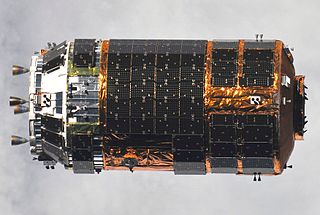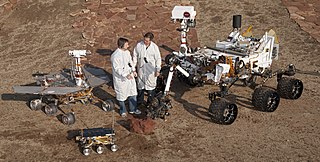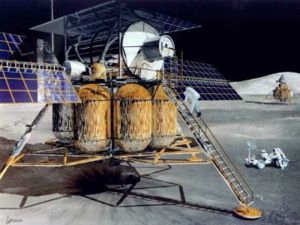
The Lunar Cruiser is the nickname of a crewed pressurized lunar rover being developed jointly by JAXA and Toyota that astronauts can drive and live on the Moon. [1]

The Lunar Cruiser is the nickname of a crewed pressurized lunar rover being developed jointly by JAXA and Toyota that astronauts can drive and live on the Moon. [1]
The Lunar Cruiser is being developed as a part of NASA's Artemis program and will enable astronaut crews to take trips across the Moon lasting up to 30-45 days, live independently from the station by using its life support system as a backup. [2] Named after the Toyota Land Cruiser, its name was chosen "because of the familiar feeling it offers the people involved in the development and manufacture of the vehicle prototype as part of the joint research project as well as the familiarity it will provide the general public." The rover is currently being manufactured, with an expected launch date in the latter half of the 2020s. The rover itself will use fuel-cell electric-vehicle technologies. [3] [4] An update by the development team in late 2023 indicated the very first cruiser would be deployed in 2029 along with the first moonbase. [5] Mitsubishi is helping develop the hydrogen electrolysis unit due to its development in new maritime technology. [6]

The Lunar Roving Vehicle (LRV) is a battery-powered four-wheeled rover used on the Moon in the last three missions of the American Apollo program during 1971 and 1972. It is popularly called the Moon buggy, a play on the term "dune buggy".

The Japan Aerospace Exploration Agency (JAXA) is the Japanese national air and space agency. Through the merger of three previously independent organizations, JAXA was formed on 1 October 2003. JAXA is responsible for research, technology development and launch of satellites into orbit, and is involved in many more advanced missions such as asteroid exploration and possible human exploration of the Moon. Its motto is One JAXA and its corporate slogan is Explore to Realize.

The H-II Transfer Vehicle (HTV), also called Kounotori, is an expendable, automated cargo spacecraft used to resupply the Kibō Japanese Experiment Module (JEM) and the International Space Station (ISS). The Japan Aerospace Exploration Agency (JAXA) has been working on the design since the early 1990s. The first mission, HTV-1, was originally intended to be launched in 2001. It launched at 17:01 UTC on 10 September 2009 on an H-IIB launch vehicle. The name Kounotori was chosen for the HTV by JAXA because "a white stork carries an image of conveying an important thing, therefore, it precisely expresses the HTV's mission to transport essential materials to the ISS". The HTV is very important for resupplying the ISS because after the retirement of the Space Shuttle it is the only vehicle that can transfer new 41.3 in (105 cm) wide International Standard Payload Racks (ISPRs) and dispose old ISPRs that can fit the 51 in (130 cm) wide tunnels between modules in the US Orbital Segment.

ILC Dover, LP is a special engineering development and manufacturing company, globally headquartered in Frederica, Delaware. ILC Dover specializes in the use of high-performance flexible materials, serving the aerospace, personal protection, and pharmaceutical industries.

The following outline is provided as an overview of and topical guide to space exploration.

A rover is a planetary surface exploration device designed to move over the rough surface of a planet or other planetary mass celestial bodies. Some rovers have been designed as land vehicles to transport members of a human spaceflight crew; others have been partially or fully autonomous robots. Rovers are typically created to land on another planet via a lander-style spacecraft, tasked to collect information about the terrain, and to take crust samples such as dust, soil, rocks, and even liquids. They are essential tools in space exploration.

The National Aeronautics and Space Administration is an independent agency of the U.S. federal government responsible for the civil space program, aeronautics research, and space research. Established in 1958, it succeeded the National Advisory Committee for Aeronautics (NACA) to give the U.S. space development effort a distinct civilian orientation, emphasizing peaceful applications in space science. It has since led most of America's space exploration programs, including Project Mercury, Project Gemini, the 1968–1972 Apollo Moon landing missions, the Skylab space station, and the Space Shuttle. Currently, NASA supports the International Space Station (ISS) along with the Commercial Crew Program, and oversees the development of the Orion spacecraft and the Space Launch System for the lunar Artemis program.

The Space Exploration Vehicle (SEV) is a modular vehicle concept developed by NASA from 2008 to 2015. It would have consisted of a pressurized cabin that could be mated either with a wheeled chassis to form a rover for planetary surface exploration or to a flying platform for open space missions such as servicing satellites and missions to near-Earth asteroids. The concept evolved from the Lunar Electric Rover (LER) concept, which in turn was a development of the Small Pressurized Rover (SPR) concept.

A lunar rover or Moon rover is a space exploration vehicle designed to move across the surface of the Moon. The Apollo program's Lunar Roving Vehicle was driven on the Moon by members of three American crews, Apollo 15, 16, and 17. Other rovers have been partially or fully autonomous robots, such as the Soviet Union's Lunokhods, Chinese Yutus, Indian Pragyan, and Japan's LEVs. Five countries have had operating rovers on the Moon: the Soviet Union, the United States, China, India, and Japan.
The (Japanese) Lunar Exploration Program is a program of robotic and human missions to the Moon undertaken by the Japanese Aerospace Exploration Agency (JAXA) and its division, the Institute of Space and Astronautical Science (ISAS). It is also one of the three major enterprises of the JAXA Space Exploration Center (JSPEC). The main goal of the program is "to elucidate the origin and evolution of the Moon and utilize the Moon in the future".

Smart Lander for Investigating Moon (SLIM) is a lunar lander mission of the Japan Aerospace Exploration Agency (JAXA). The lander's initial launch date in 2021 was postponed until 2023 due to delays in its rideshare, the X-Ray Imaging and Spectroscopy Mission (XRISM). On 6 September 2023 at 23:42 UTC, XRISM launched, and SLIM separated from it later that day.

Blue Moon is a family of lunar landers and their associated infrastructure, intended to carry humans and cargo to the Moon, under development by a consortium led by Blue Origin and including Lockheed Martin, Draper, Boeing, Astrobotic, and Honeybee Robotics. Two versions of Blue Moon are under development: a robotic lander planned to land on the Moon in 2024, and a larger human lander planned to land a crew of four astronauts on the lunar surface for the NASA Artemis V mission in 2029.

Martian Moons eXploration (MMX) is a robotic space probe set for launch in 2026 to bring back the first samples from Mars' largest moon Phobos. Developed by the Japan Aerospace Exploration Agency (JAXA) and announced on 9 June 2015, MMX will land and collect samples from Phobos once or twice, along with conducting Deimos flyby observations and monitoring Mars's climate.

The Artemis program is a Moon exploration program that is led by the United States' National Aeronoautics and Space Administration (NASA) and was formally established in 2017 via Space Policy Directive 1. The Artemis program is intended to reestablish a human presence on the Moon for the first time since the Apollo 17 moon mission in 1972. The program's stated long-term goal is to establish a permanent base on the Moon to facilitate human missions to Mars.

Artemis 5 is the fifth planned mission of NASA's Artemis program and the first crewed flight of the Blue Moon lander. The mission will launch four astronauts on a Space Launch System rocket and an Orion to the Lunar Gateway and will be the third lunar landing of the Artemis program. In addition, Artemis V will also deliver two new elements to the Gateway Space Station.
HERACLES is a planned robotic transport system to and from the Moon by Europe (ESA), Japan (JAXA) and Canada (CSA) that will feature a lander called the European Large Logistic Lander, a Lunar Ascent Element, and a rover. The lander can be configured for different operations such as up to 1.5 tons of cargo delivery, sample-returns, or prospecting resources found on the Moon.

First Lunar Outpost was a proposal for a crewed lunar mission that would have launched sometime in the 2010s. It was part of George H. W. Bush's Space Exploration Initiative. The main purpose of the proposal was to offer a much cheaper alternative to NASA's 90-day study from 1989 by a factor of US$30 billion. Although it did not gather much mainstream attention, NASA dedicated much time to assembling a very detailed and thorough proposal. However, the entire Space Exploration Initiative was cancelled soon after the proposal's completion, and NASA had to close the Office of Space Exploration in March 1993.
The Dynetics Autonomous Logistics Platform for All-Moon Cargo Access (ALPACA)—also known as Dynetics HLS—(ILV) is a human spaceflight lunar lander design concept proposed in 2020/21 for the NASA Human Landing System (HLS) component of the Artemis program. Dynetics was the lead contractor for the ALPACA lander—other contractors included Sierra Nevada Corporation—for NASA's Artemis Program.

The Lunar Terrain Vehicle (LTV) is an unpressurized rover being developed for NASA that astronauts can drive on the Moon while wearing their spacesuits. The development of the LTV is a part of NASA's Artemis Program, which involves returning astronauts to the Moon, specifically the lunar south pole, by 2026, but the LTV will not fly until Artemis V in 2030 at the earliest. The LTV will be the first crewed lunar rover developed by NASA since the Lunar Roving Vehicle used during the Apollo program.